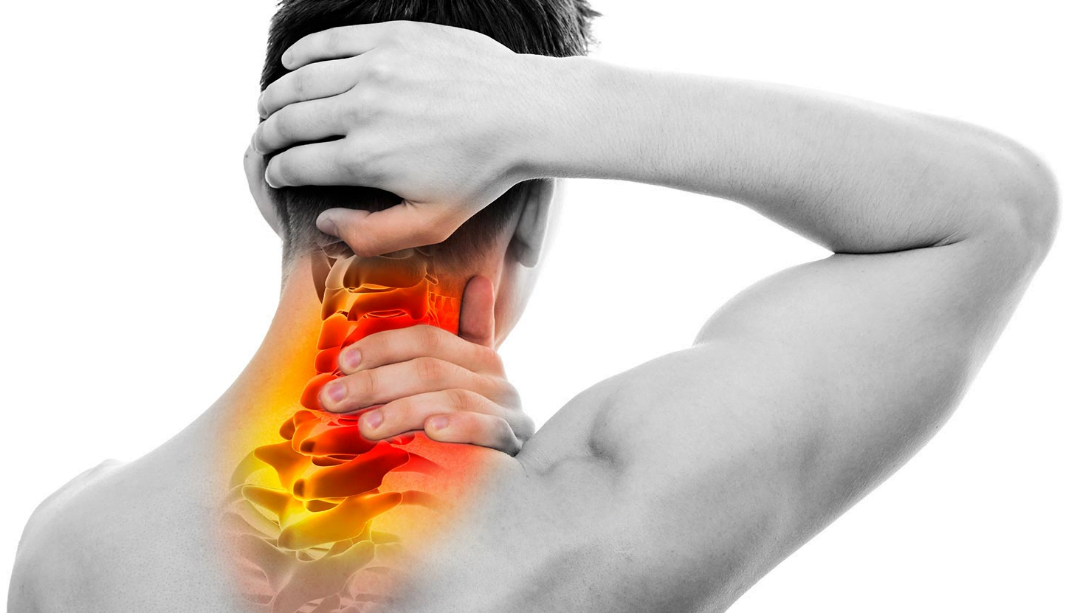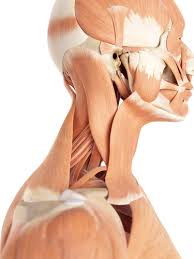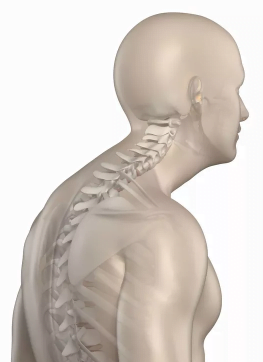Why does my neck hurt when I turn it? A guide to mechanical neck pain
 DISCLAIMER – This guide is intended for information only, it does not constitute advice, a diagnosis or a recommendation of action. If you are experiencing neck pain that is accompanied by sudden weight loss, fever, problems swallowing food, changes to your voice or other senses, dizziness, is not made better with rest and not aggravated by movement, or is a result of a recent impact or trauma then you must seek medical help as soon as possible.
DISCLAIMER – This guide is intended for information only, it does not constitute advice, a diagnosis or a recommendation of action. If you are experiencing neck pain that is accompanied by sudden weight loss, fever, problems swallowing food, changes to your voice or other senses, dizziness, is not made better with rest and not aggravated by movement, or is a result of a recent impact or trauma then you must seek medical help as soon as possible.
Who gets neck pain?
Mechanical neck pain is usually located around the side and back of the neck and may also include the upper back. It is most often accompanied by some muscle spasm and some pain associated with movement, and certain movements of the head and neck may be reduced or performed in a different way from before the pain appeared (1). The peak age group to experience mechanical neck pain is between 30-59 years old and is more commonly experienced by women. Three out of four people will experience neck pain over the course of their lifetime (2), and unsurprisingly it is the second most common reason to seek osteopathic treatment (1). 85% of neck pain can be attributed to chronic stressors of the neck’s mechanical structures, such as repetitive work tasks, sitting at work for prolonged periods, cycling and driving position (3), other biomechanical factors such as tightness in upper back muscles and joints can also contribute to a the possibility of developing neck pain (2).
What structures in the neck can cause pain?
 The bones and joints of the neck are structured to provide protection for the spinal cord as well as allowing for large movements (the largest in the spine), which are provided by a complex array of muscles starting from the skull and reaching as far down as the mid back. These muscles work hard at all times, producing over 600 movements every day. There are seven bones in the neck (C1-C7) with the junctures at each forming a ‘facet joint’. Both the muscles and the joints are capable of producing painful symptoms. In between these bones there are nerves exiting from the spinal cord and supplying areas up in the head, down into the hands, and to structures such as the diaphragm. This means that dysfunction and injuries to the neck can cause pain and other symptoms in many other areas of the body. In between the bones are the intervertebral discs which are there to maintain space between each vertebrae, as well as allowing some movement and absorbing the forces produced from movement. Traumatic injuries and changes that happen to the discs as we get older can result in changes to how the joints, muscles and nerves perform producing both acute and chronic problems (9).
The bones and joints of the neck are structured to provide protection for the spinal cord as well as allowing for large movements (the largest in the spine), which are provided by a complex array of muscles starting from the skull and reaching as far down as the mid back. These muscles work hard at all times, producing over 600 movements every day. There are seven bones in the neck (C1-C7) with the junctures at each forming a ‘facet joint’. Both the muscles and the joints are capable of producing painful symptoms. In between these bones there are nerves exiting from the spinal cord and supplying areas up in the head, down into the hands, and to structures such as the diaphragm. This means that dysfunction and injuries to the neck can cause pain and other symptoms in many other areas of the body. In between the bones are the intervertebral discs which are there to maintain space between each vertebrae, as well as allowing some movement and absorbing the forces produced from movement. Traumatic injuries and changes that happen to the discs as we get older can result in changes to how the joints, muscles and nerves perform producing both acute and chronic problems (9).
 Returning to our original question, why does it hurt when I turn my head? The answer to this is (as is common in our line of work) it depends on what type of pain you have and how it got there. Any disruption to the biomechanics of the neck can produce a dysfunction that produces pain. Due to the ‘tautness’ of many muscles that hold the head up in position an excessive and sudden force that makes the head move forward, back or to the sides (such as a whiplash injury) can produce muscle and ligament damage (4). More longstanding and chronic neck pain is often associated with repetitive tasks that are performed over a long period of time, such as driving or computer work (1).
Returning to our original question, why does it hurt when I turn my head? The answer to this is (as is common in our line of work) it depends on what type of pain you have and how it got there. Any disruption to the biomechanics of the neck can produce a dysfunction that produces pain. Due to the ‘tautness’ of many muscles that hold the head up in position an excessive and sudden force that makes the head move forward, back or to the sides (such as a whiplash injury) can produce muscle and ligament damage (4). More longstanding and chronic neck pain is often associated with repetitive tasks that are performed over a long period of time, such as driving or computer work (1).
Whiplash and Whiplash Associated Disorder
(please also see our full article, Whiplash…A pain in the neck)
 A sudden force, most commonly seen in car accidents, where the head is quickly thrown forwards then backwards can result in an acute set of symptoms such as neck, head, and shoulder pain. There may also be some numbness, ’pins and needles’, or shooting pains into the arm and hand. There may also be some dizziness and ‘brain fog’. Sometimes a person who has suffered a whiplash injury may not get pain until a couple of days after the incident. If there is no significant trauma then most people find their symptoms resolve over a matter of days or weeks, however a significant amount of people develop chronic whiplash meaning they have pain and dysfunction for over 6 months. The short term effects of whiplash can be relieved by manual therapy from an osteopath, exercise prescription and advice on their symptoms (5). For those who have a more chronic problem then exercises tend to be more productive (6).
A sudden force, most commonly seen in car accidents, where the head is quickly thrown forwards then backwards can result in an acute set of symptoms such as neck, head, and shoulder pain. There may also be some numbness, ’pins and needles’, or shooting pains into the arm and hand. There may also be some dizziness and ‘brain fog’. Sometimes a person who has suffered a whiplash injury may not get pain until a couple of days after the incident. If there is no significant trauma then most people find their symptoms resolve over a matter of days or weeks, however a significant amount of people develop chronic whiplash meaning they have pain and dysfunction for over 6 months. The short term effects of whiplash can be relieved by manual therapy from an osteopath, exercise prescription and advice on their symptoms (5). For those who have a more chronic problem then exercises tend to be more productive (6).
‘Cricked’ or ‘locked’ neck (Cervical Facet Syndrome)
 This is one set of symptoms that we commonly see in our clinic. Usually the person will come in and say that they slept in an odd position, or they moved the neck suddenly and then the neck ‘locked up’. Commonly this can be due to cervical facet joints that have become irritated or inflamed resulting in some muscular spasm. In the younger population this type of pain is usually due to a sudden movement in the upper neck at levels C2-3, however people over 45 due to changes in the vertebral discs as we get older the affected levels are more likely to be C4-C7 (8). In both these age groups sufferers usually describe a very specific location of pain in the neck with some more diffuse pain in the shoulder or upper back (7), there may also be some pain or numbness in the arm, but rarely past the elbow. People who suffer this type of pain will struggle to turn the head and looking up may be worse than looking down, however all movements may be painful. As this type of pain can be severe and debilitating it is best to seek help sooner rather than later. An accurate diagnosis from an osteopath will inform how best to get rid of the pain in the short and long term (4). Manual therapy techniques that involve mobilisation and manipulation of the facet joints, coupled with exercise prescription that help increase the movement in the neck can provide good short term relief (7). To avoid relapses and to help resolve the underlying issue, massage, exercise and advice on how to avoid strain on the neck (pillow use, workplace advice etc.) are usually the best options (1).
This is one set of symptoms that we commonly see in our clinic. Usually the person will come in and say that they slept in an odd position, or they moved the neck suddenly and then the neck ‘locked up’. Commonly this can be due to cervical facet joints that have become irritated or inflamed resulting in some muscular spasm. In the younger population this type of pain is usually due to a sudden movement in the upper neck at levels C2-3, however people over 45 due to changes in the vertebral discs as we get older the affected levels are more likely to be C4-C7 (8). In both these age groups sufferers usually describe a very specific location of pain in the neck with some more diffuse pain in the shoulder or upper back (7), there may also be some pain or numbness in the arm, but rarely past the elbow. People who suffer this type of pain will struggle to turn the head and looking up may be worse than looking down, however all movements may be painful. As this type of pain can be severe and debilitating it is best to seek help sooner rather than later. An accurate diagnosis from an osteopath will inform how best to get rid of the pain in the short and long term (4). Manual therapy techniques that involve mobilisation and manipulation of the facet joints, coupled with exercise prescription that help increase the movement in the neck can provide good short term relief (7). To avoid relapses and to help resolve the underlying issue, massage, exercise and advice on how to avoid strain on the neck (pillow use, workplace advice etc.) are usually the best options (1).
Chronic neck pain/stiffness
 Everyone gets a stiff neck once in a while, but some people have seem to have almost constant pain and stiffness in the neck. People who suffer from this type of pain can have either some age related changes to the vertebral discs, or are placing an excessive demand on the structures of the neck through activities such as manual labour, long distance cycling, or prolonged computer use.
Everyone gets a stiff neck once in a while, but some people have seem to have almost constant pain and stiffness in the neck. People who suffer from this type of pain can have either some age related changes to the vertebral discs, or are placing an excessive demand on the structures of the neck through activities such as manual labour, long distance cycling, or prolonged computer use.
As we go through middle age the intervertebral discs in our spine begin to stiffen and we lose the cartilage around the joints leading to a change in joint biomechanics and a loss of movement (degenerative disc disease). This often appears as a slow developing dull achy neck pain in the lower sections of the neck (C5-C7) with a loss of ranges of motion (7). Relief from this type of pain can be found in the very short term by a heat pack, however a longer term solution is to have an osteopath mobilise the affected joints in the neck and use massage techniques to relax the muscles around the neck and upper back (4, 7).
The other group, those who need to spend a long time at a computer or other demanding task, can develop a postural problem where the chin is protruded and the head is forward of the shoulders. This not only compresses the upper joints in the neck but places a lot of strain on the upper back and shoulder muscles resulting in burning or aching across the upper back and neck, there may also be some headache like pain at the base of the skull (8). Usually these people’s pain is best treated in the short term with some joint manipulation and massage work, however to resolve the problem the sufferer must correct the reason for the problem in the first place. In the case of computer workers a workstation assessment (click here for our worksheet on how to set up your workstation) should be undertaken and strengthening exercises of the mid back and shoulders can be very helpful (7).
What is our experience as osteopaths?
 We see a lot of people with neck pain, around 20% of them will be in acute pain, the rest will be in the ‘stiff and achey’ group. We find that an accurate assessment and diagnosis leads us to a full understanding of why a person has developed neck pain and allows us to prescribe a mix of osteopathic treatment sessions and exercises that will target the source of the pain and, in most cases, take the pain away and increase movement. Most people get relief from a handful of appointments, however some people, usually those who have degenerative disc disease, may require ongoing intermittent treatment to maintain the movement in the neck.
We see a lot of people with neck pain, around 20% of them will be in acute pain, the rest will be in the ‘stiff and achey’ group. We find that an accurate assessment and diagnosis leads us to a full understanding of why a person has developed neck pain and allows us to prescribe a mix of osteopathic treatment sessions and exercises that will target the source of the pain and, in most cases, take the pain away and increase movement. Most people get relief from a handful of appointments, however some people, usually those who have degenerative disc disease, may require ongoing intermittent treatment to maintain the movement in the neck.
Do you want to know what is causing your pain and if we can help? Why not take advantage of our new patient assessment introductory offer to get you started towards a tailor made recovery plan for only £19.
Are you in a lot of pain and want to get better as soon as possible? If so then why not book in for a new patient consultation, with treatment on the day, for £75.
We are also there to help you from home. Take a look at our suite of exercise resources and advice sheets which you can easily download and use from home.
References
1 – Seffinger, M. and Hruby, R., 2007. Evidence Based Manual Medicine – A Problem Based Approach. Philadelphia, Elselvier.
2 – Bogduk, N. Mercer, S. (2000). Biomechanics of the cervical spine, normal kinematics. Clinical Biomechanics, 15, pp 633-648.
3- Narayan, P. Haid, R. (2001). Treatment of degenerative cervical disc disease. Neurol Clin, 19, pp217-229.
4 – Souza, T. (2009). Differential Diagnosis and Management for the Chiropractor. 4th ed, Jones and Bartlett, Sudbury.
5 – Vendrig A, et al. (2000). Results of a multimodal treatment program for patients with chronic symptoms after a whiplash injury of the neck. Spine, 25 (2): p.238–244 (4).
6 – Teasell RW. Et al, (2010). A research synthesis of therapeutic interventions for whiplash-associated disorder (WAD): Part 2 – interventions for acute WAD. Pain Res Manage; 15(5):295-304.
7 – Carnes, M, & Vizniak, N. (2011). Conditions Manual. Professional Health Systems, Canada.
8 – Brukner, P. and Khan, K. (2007). Clinical Sports Medicine (3rd Ed). McGraw Hill, Sydney.
9 – Levangie, P. and Norkin, C. (2005) Joint Structure and Function: A Comprehensive Analysis (4th ed). F. A. Davis, Philadelphia.
